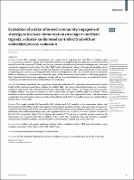| dc.contributor.author | Bruce, Jane | |
| dc.contributor.author | Chantler, Tracey | |
| dc.contributor.author | Kumakech, Edward | |
| dc.contributor.author | Mawanda, Ashiraf | |
| dc.contributor.author | Olorunsaiye, Comfort | |
| dc.contributor.author | Schmucker, Laura | |
| dc.contributor.author | Kiapi, Lilian | |
| dc.contributor.author | Landegger, Justine | |
| dc.contributor.author | Webster, Jayne | |
| dc.date.accessioned | 2020-11-11T07:14:55Z | |
| dc.date.available | 2020-11-11T07:14:55Z | |
| dc.date.issued | 2018 | |
| dc.identifier.citation | Bruce, J., Chantler, T., Kumakech, E., Mawanda, A., Olorunsaiye, C., Schmucker, L., ... & Webster, J. (2018). Evaluation of a data-informed community engagement strategy to increase immunisation coverage in northern Uganda: a cluster-randomised controlled trial with an embedded process evaluation. The Lancet Global Health, 6, S15. | en_US |
| dc.identifier.uri | https://hdl.handle.net/123456789/188 | |
| dc.description.abstract | Background The 2016 Ugandan Demographic and Health Survey indicated that only 86% of children (aged
12–23 months) in northern Uganda had received the third dose of diphtheria-tetanus-pertussis vaccine (DTP3) and
only 65% were fully immunised. To help close this gap, the International Rescue Committee developed a data-informed
community engagement intervention, the Fifth Child Project, informed by a theory of change and including: (1) an
mhealth tool used by health-facility-based staff and defaulter tracing forms used by community health workers aimed
at improving data accuracy, (2) training of health workers in interpersonal skills, and (3) involvement of community
leaders in planning vaccine outreaches. To test the impact of this intervention and examine its underlying hypothesis
that a data-informed community engagement strategy will increase immunisation coverage, we conducted a clusterrandomised
controlled trial with an embedded process evaluation.
Methods At baseline, a household two-stage cluster survey was conducted in 32 clusters (16 intervention and 16 control
health facility catchment areas) from mid-June to mid-July, 2016. The survey collected information on vaccinations,
caregivers’ interactions with community-based and facility-based health workers, and reasons for non-vaccination
of eligible children. The primary outcome was DPT3 and measles coverage in children aged 9–23 months. Process
evaluation activities included: quarterly monitoring reports, interviews, focus group discussions, and observations
conducted in four intervention and two control clusters (March–April, 2017). The endline survey was conducted from
Sept 19, 2017, to Oct 2, 2017.
Findings The sample included 916 households (935 children aged 9–23 months) in the intervention clusters and
881 households (897 children aged 9–23 months) in control clusters. Baseline estimates of immunisation coverage were
similar for intervention and control arms. Both arms combined baseline coverage of DTP3 and measles vaccines using
information from child immunisation cards, and caregiver recall was 78·3% (95% CI 76·0–81·5) and 64·6% (95% CI
60·9–67·3%), respectively. About 19% of children who received DTP1 had not received the measles vaccine in the
intervention arm, compared with 21% of children in the control arm at baseline. The major barriers to complete
immunisation included caregivers’ lack of awareness of immunisation schedule and vaccine stock-outs.
Interpretation Endline and process evaluation findings will be available in March 2018 and will provide a more
complete assessment of the impact of the Fifth Child Project. | en_US |
| dc.language.iso | en | en_US |
| dc.publisher | The Lancet Global Health | en_US |
| dc.subject | community engagement | en_US |
| dc.subject | immunization | en_US |
| dc.subject | Northern Uganda | en_US |
| dc.title | Evaluation of a data-informed community engagement strategy to increase immunisation coverage in northern Uganda: a cluster-randomised controlled trial with an embedded process evaluation | en_US |
| dc.type | Article | en_US |

